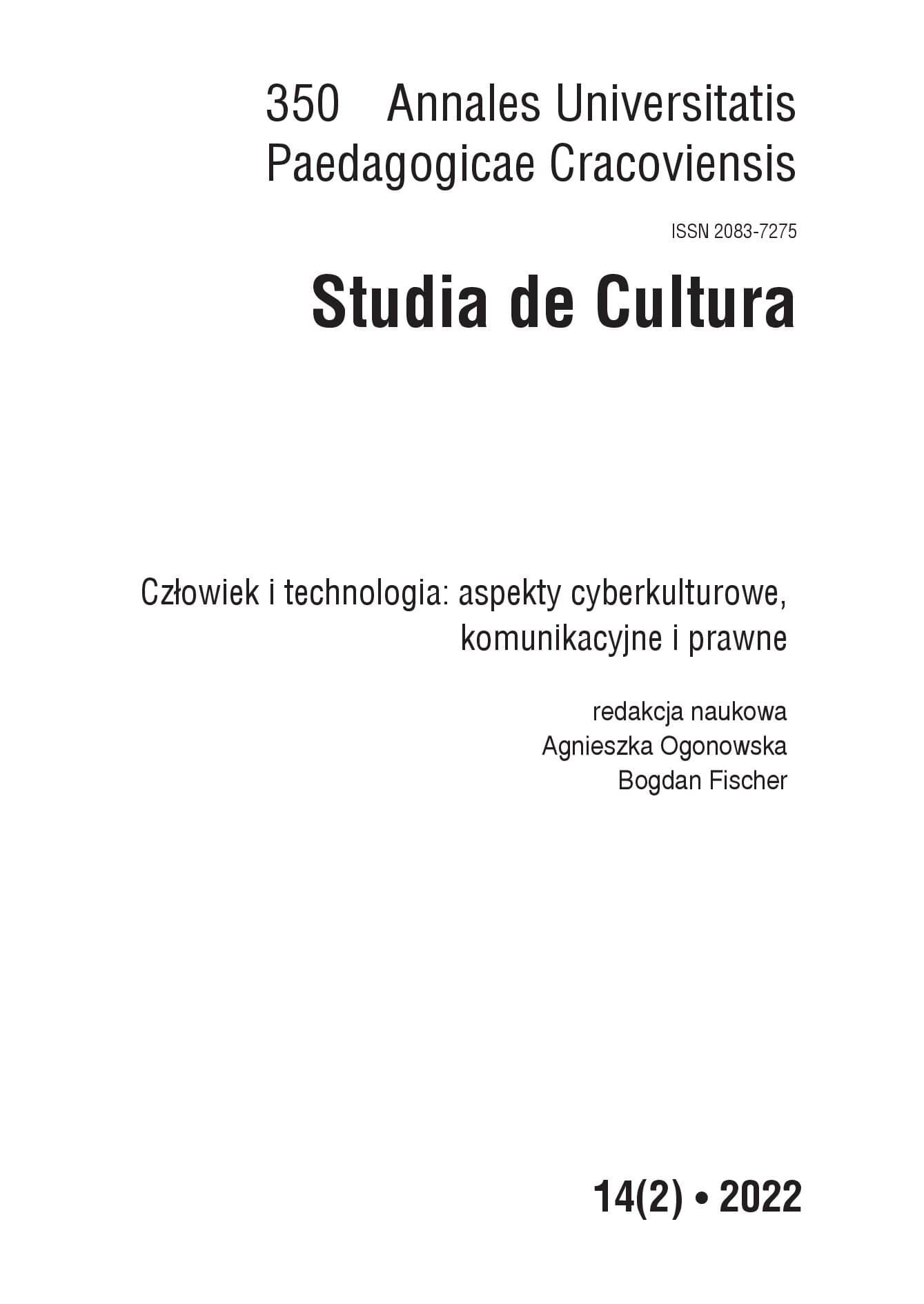Abstract
The topic of the article is asymmetrical relation between a user and a system, the latter understood as an obscure structure, shaping forms of interaction between a human being and technology using soft power. It is visible in a contradiction between a language (called chirping) of system-generated messages present in digital daily life, and their persuasive and oppressive impact, compared with examples of subversive strategies practiced with tactical media art, such as: obfuscation, over-identification and estrangement as well as theoretical proposals of tactics as a form of soft resistance.
References
Bridle James. 2014. Homo Sacer. https://jamesbridle.com/works/homo-sacer. (dostęp: 18.09.2021).
View in Google Scholar
Bridle James. 2018. New Dark Age. Technology and the End of the Future. London.
View in Google Scholar
Brunton Finn, Nissenbaum Helen. 2016. Zmyl trop. Na barykadach prywatności w sieci. Przewodnik. Jacek Konieczny (przeł.). Warszawa.
View in Google Scholar
Debord Guy. 2006. Społeczeństwo spektaklu oraz Rozważania o społeczeństwie spektaklu. Mateusz Kwaterko (przeł.). Warszawa.
View in Google Scholar
De Certeau Michel. 2008. Wynaleźć codzienność. Sztuki działania. Katarzyna Thiel-Jańczuk (przeł.). Kraków.
View in Google Scholar
Dragona Daphne. 2016a. „Co-curricular Infrastructure”. Transmediale Journal. Elvia Wilk (red.). https://transmediale.de/content/co-curricular-infrastructure. (dostęp: 18.09.2021).
View in Google Scholar
Dragona Daphne. 2016b. What Is Left to Subvert? Artistic Methodologies for a Post-Digital World. W: Across & Beyond – A transmediale Reader on Post-Digital Practices, Concepts, and Institutions. Ryan Bishop i in. (red.). Berlin. 184–196.
View in Google Scholar
Franke Anselm, Hankey Stephanie, Tuszynski Marek. 2014. Nervous Systems. An Introduction. W: Nervous Systems. Anselm Franke, Stephanie Hankey, Marek Tuszynski (red.). Leipzig. 10–28.
View in Google Scholar
Goral Aleksandra. 2018. „Szum na cyfrowe lęki. Ślad i podejrzliwość w świecie danych”. Kultura Współczesna 110.2. 62–77.
View in Google Scholar
Lialina Olia. 2012. „Turing Complete User”. Contemporary Home Computing. http://contemporary-home-computing.org/turing-complete-user/. (dostęp: 18.09.2021).
View in Google Scholar
Lialina Olia. 2016. Not Art&Tech. W: Across & Beyond – A Transmediale Reader on Post Digital Practices, Concepts, and Institutions. Ryan Bishop i in. (red.). Berlin. 135–145.
View in Google Scholar
Lovink Geert, Garcia David. 1997. The ABC of Tactical Media. Nettime. https://www.nettime.org/Lists-Archives/nettime-l-9705/msg00096.html. (dostęp: 18.09.2021).
View in Google Scholar
Kafka Franz[iszek]. 1936. Proces. Bruno Schulz (Józefina Szelińska) (przeł.). Warszawa.
View in Google Scholar
Manovich Lev. 2013. Software Takes Command. New York.
View in Google Scholar
McLuhan Marshall. 1977. „The Medium Is the Message”. Wykład w telewizji ABC.
View in Google Scholar
Morozov Evgeny. 2014. To Save Everything Click Here. The Folly of Technological Solutionism. New York.
View in Google Scholar
Naughton John. 2019. „»The goal is to automate us«. Welcome to the Age of Surveillance Capitalism”. The Guardian. https://www.theguardian.com/technology/2019/jan/ 20/shoshana-zuboff-age-of-surveillance-capitalism-google-facebook. (dostęp: 6.06.2022).
View in Google Scholar
Nelson Ted. 2009. Geeks Bearing Gifts. Sausalito.
View in Google Scholar
Norman Donald A. 1999. „Affordances, Conventions and Design”. Interactions 6.3. 38–43.
View in Google Scholar
Norman Donald A. 2006. Words Matter. Talk About People: Not Customers, Not Consumers, Not Users. https://jnd.org/words_matter_talk_about_people_not_customers_not_consumers_not_users/. (dostęp: 18.09.2021).
View in Google Scholar
Nye Joseph. 2007. Soft Power. Jak osiągnąć sukces w polityce światowej – perswazyjne środki oddziaływania politycznego (kultura, propaganda, dyplomacja). Jakub Zaborowski (przeł.). Warszawa.
View in Google Scholar
O’Murchu Nora. 2021. for refusal. https://transmediale.de/theme. (dostęp: 18.09.2021).
View in Google Scholar
O’Neil Cathy. 2017. Broń matematycznej zagłady. Jak algorytmy zwiększają nierówności i zagrażają demokracji. Marcin Z. Zieliński (przeł.). Warszawa.
View in Google Scholar
Odell Jenny. 2020. Jak robić nic? Manifest przeciw kultowi produktywności. Aleksandra Weksej (przeł.). Białystok.
View in Google Scholar
Ogonowska Agnieszka. 2021. „Media ucieleśnione. (Nowe) konteksty badawcze w relacjach media – ciało”. Studia de Cultura nr 13.1. 36–54.
View in Google Scholar
Postman Neil. 1995. Technopol. Triumf techniki nad kulturą. Anna Tanalska-Dulęba (przeł.). Warszawa.
View in Google Scholar
Thoreau Henry David. 2006. Obywatelskie nieposłuszeństwo. Halina Cieplińska (przeł.). Poznań.
View in Google Scholar
Wark McKenzie. 2013. „A Ludic Century. Games, Aesthetics, the Twenty-First Century”. Public Seminar. https://publicseminar.org/2013/11/a-ludic-century/. (dostęp: 18.09.2021).
View in Google Scholar
Wark McKenzie. 2014. Spektakl dezintegracji. Sytuacjonistyczne drogi wyjścia z XX wieku. Katarzyna Makaruk (przeł.). Warszawa.
View in Google Scholar
Wiktor Arkadiusz, Przebięda Dominika. 2020. „Użytkownik”. Encyklopedia Zarządzania https://mfiles.pl/pl/index.php/Użytkownik. (dostęp: 18.09.2021).
View in Google Scholar
Wójtowicz Ewa. 2013. „Niepozorny impet. Nanoaktywizm w kulturze partycypacji – wobec teorii i praktyki”. Fragile 2.20. 5–9.
View in Google Scholar
Zuboff Shoshana. 2015. „Big Other. Surveillance Capitalism and the Prospects of an Information Civilization”. Journal of Information Technology. 30. 75–89.
View in Google Scholar
Abandoned IBM Country Club, Endicott NY. 2020. AI Lab journeys. Tega Brain, Sam Lavigne, Hannah Jayanti (reż.). https://ars.electronica.art/keplersgardens/en/abandoned/ (dostęp: 21.09.2021).
View in Google Scholar
Coded Bias. 2020. Shalini Kantayya (reż.).
View in Google Scholar
TouchGamePlay. 2012. Official Apple (New) iPad Trailer. YouTube. https://www.youtube.com/watch?v=Aq3HrsM1ql8. (dostęp: 21.09.2021).
View in Google Scholar

This work is licensed under a Creative Commons Attribution-NonCommercial 4.0 International License.

